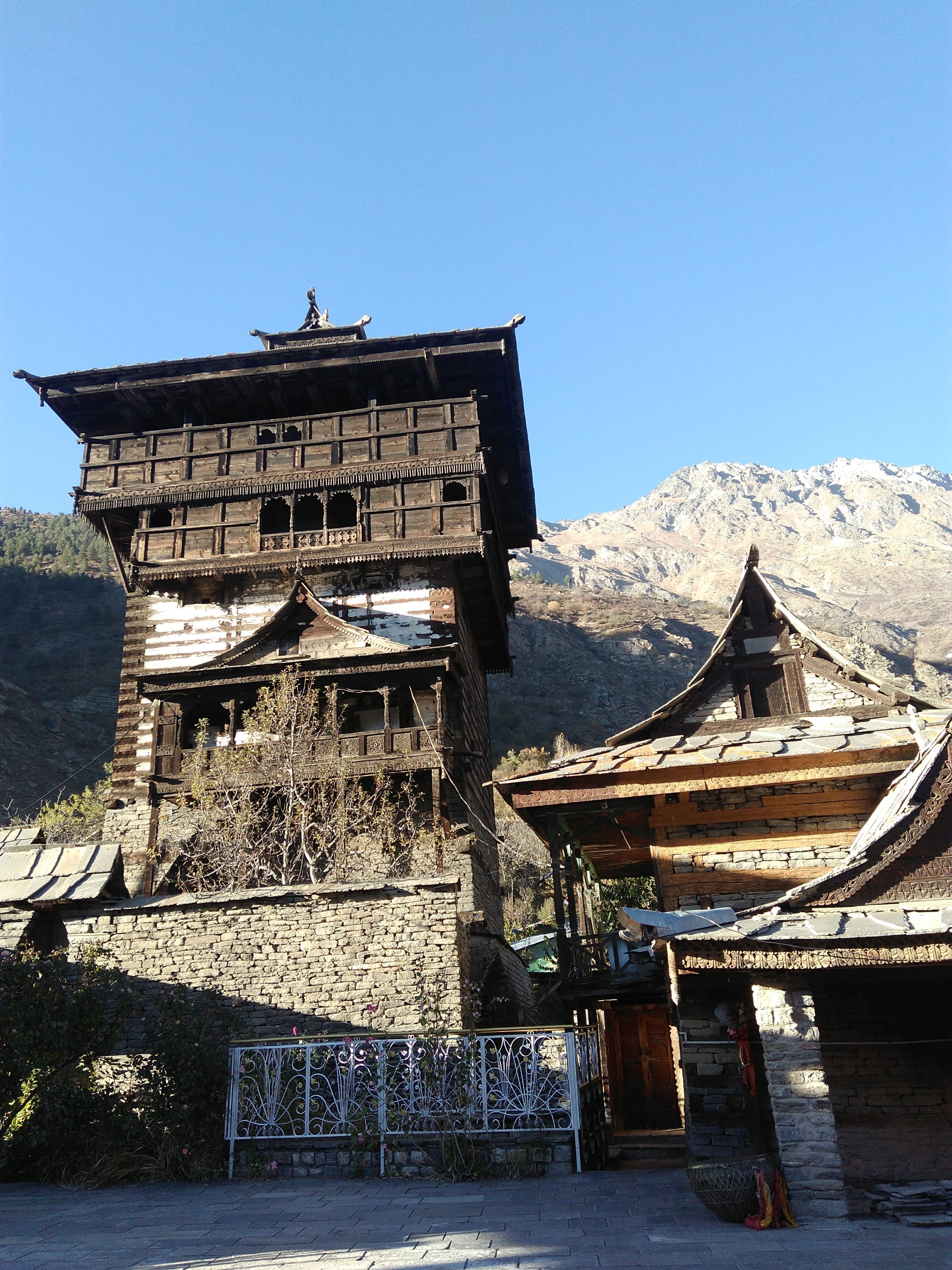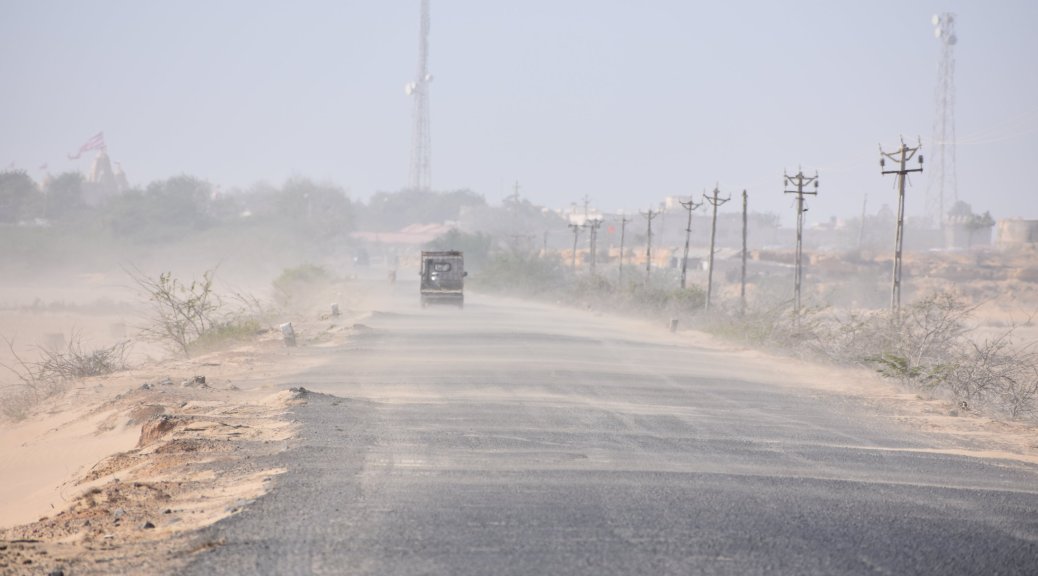As I arrived at Sangla, the setting sun had already laid a golden welcome… I started to walk around the town looking for a homestay. After walking here and there, up and down, I decided to settle down at a homestay, which seemed like a pretty big bungalow. The owner of the house was away, and it was let to the caretaker’s responsibility. I was the only guest. However, this seemed to be better than all the properties I had seen thus far. I freshened up, unpacked and unwound myself while watching the daily evening procession of the deity of the ‘Chandi Mata’ temple from the homestay itself.
Post sunset, I wore all the thermals I needed and ventured out to explore the town. The commercial area seemed just like any other small town I had been before and didn’t want to get too adventurous on my first day in the valley. In the entire town, I was drawn towards a very small restaurant called ’The Buddhist Café’. I was being just one of those typical Indian tourists in the Himalayas; I was tempted to eat momos 😛 The place rather looked dinghy with dim lights and no customers in their main dining area. On enquiry if the restaurant was closed, I was greeted by an old Buddhist lady who guided me to follow her to the kitchen inside. Despite being a little suspicious of her gesture and given the shady looking walkway, I continued to follow her. She made me sit at a table where she served me steaming hot momos and black coffee after taking my orders.
There were a couple of people who came in and out whom the lady attended to but did not take any money from. It seemed to me that they were mostly labour who helped her in fetching supplies to her kitchen and she retuned their favour by providing them free meals. She was speaking very gently to them as if one would talk to their family members. I felt so much positivity emanating from this lady. Eventually, she pulled a chair next to me and settled down to have a long conversation with me. She enquired about my journey and said a few things about herself and her family. We both were so engrossed in our conversation that it was 09.00.p.m. by the time I realized that I had quite a distance to walk back in the darkness to reach my place of stay. The lady took my hand in hers and asked me to promise that I would visit her daily for as long as I was in Sangla. “Tumse baat karke bahut accha laga mujhe. Kal Aajao, gappe maarenge. Zaroor aana, mein intezaar karoongi”, she said. Amused, I left by promising her that I would return.
This trip has been compiled into a book. If you like to read about the complete journey, you can avail it on Amazon or read it for free with your kindle. Use the link below.
I was an early riser on the following morning in order to make it to the bus stand on time. There was only one bus that ferried passengers to and from the last village in this part of the Indian borders. It ran twice a day, once in the morning and once in the evening. Chitkul is a tiny settlement beyond which, the mountains belong to Tibet & China. After having read enough articles on the internet, I wanted to check this off from my list of places to visit in Himachal. I however de-boarded the bus at a village called Rakcham, a few kilometers ahead of Chitkul. I was standing on the rear side of the famous Kinnaur Kailash mountains. With curious villagers staring at me as if I was a lost alien wandering alone and children walking to school posing for photos looking at my DSLR, with a beautiful sunrise over the mist laden valley and the gushing Baspa river on the other side, the morning walk on the empty road felt magical. Although I had seen apple trees earlier, it was the first time I was seeing apple orchards. The houses in the settlements on the slopes were unique to the area. I spent good amount of time exploring the village perched on hilltop and down in the cold waters of the Baspa before settling down with a cup of sea-buck thorn juice at a campsite that was being disassembled.

I had read that Rakcham valley looked vibrant with pink flowers of a native millet during its season. But I seemed to have arrived late to see the famous pink fields of Rakcham. Anyway, the orchards had turned the valley equally vibrant, in myriad shades of golden. But, honestly, there was nothing specific to see or do there, apart from the solitude that I had found thus far in my trip. I walked back to the main road and enquired with the shopkeepers about getting to Chitkul. A few localites who overheard my enquiries tried to pitch in their suggestions. Going by their suggestions, I waited by the roadside engaging myself in answering the enquiries about my solo travel. It was well over half an-hour as a shared jeep arrived, which they asked me to board to reach Chitkul. Just as the jeep cranked to start, one of the men talking to me asked the driver to wait. The man ran to a shop and returned with a bag. “It was nice talking to you; this is for your way.” he said while dumping a bag full of apples into my hand… I picked two from the bag (not wanting to disappoint him), thanked him warmly for his gesture and convinced him that I couldn’t carry so much luggage with me and bid him goodbye.
The road ahead was bumpy, yet interesting. It passes through forest area that was in bloom, opened to large meadows and then, the snowcapped peaks appeared rather suddenly. Foreigners need to register at the check post that falls enroute as Chitkul is a sensitive area guarded by the ITBP. On reaching Chitkul, I started to walk towards the viewpoint. Yes, no doubt it looked beautiful and I could walk right into the river below that demarks the border. But my heart skipped a beat when I saw the solitary Indian national tricolor waving in the middle of nowhere. Apart from taking a walk along the valley and exploring the tiny hamlet, there seemed nothing much to do. There are quite a few options to stay at both Chitkul and Rakcham, but for a moment, I feared the temperature that I was warned about. The temperatures in Chitkul are colder than anywhere else in Kinnaur. That’s why I changed my mind to return to Sangla for the night. As there was still lot of time left before the bus started, I decided to walk towards Rakcham so that I could click some good landscape photographs along my way. Anyway, the bus arrived in a while and I returned to Sangla.

There was still enough daylight time left, and I decided to explore Sangla that evening. I climbed up the Kamru fort from where I could see the magnificent view of the town and the golden sunset that had welcomed me last evening. An ancient wooden temple stands strong on top of the fort and looks brilliant with its detailed sculptures and friezes. There is a dress-code to follow (a head gear and a waist band needs to be worn) to enter inside. Since most of us there didn’t have it, we had to wait for the priest to provide the same to us, and go inside, in turns. The priest also gave me a peak into the history of the fort and how the temple came into existence. It felt very peaceful and I sat back there until the sun had gone down completely.

I had decided to leave Sangla on the following morning to continue my journey ahead. I had also not forgotten that I had promised someone that I would visit her. I wanted to inform her before leaving. That’s why I then headed towards her café for that evening. It is hard to explain how excited she was at seeing me. “I wasn’t sure that you would return. But I was looking for your way”, she exclaimed! She served me noodles and black tea, introduced me to her son whom she had called to talk to me and found good company in talking to me. After a couple of hours had passed, I informed her that I was going to take her leave. Guess what? She gave me a rucksack full of apples which she had specially bought and kept for me. She didn’t own any orchard and hence, she ensured she bought the best apples as souvenirs for me. When I say BEST, I mean THE BEST…. Kinnauri Golden apples! Can you imagine me carrying a rucksack full of apples (souvenirs!!) along with 10kgs of additional backpack that I already had. for the rest of my journey??? 😀 I convinced her that I was sorry, and I couldn’t accommodate so many apples in my luggage. And she still managed to squeeze in a good few kilos telling 2 apples for each member in my family, back in Bangalore…!! She had tears as she saw me off and I cried as I was missing my mom! Sometimes, you never understand how connections work with strangers…
Next day, there I was… Inside the bus, chattering in the cold morning… on my way to my next destination in this sojourn: Kalpa







